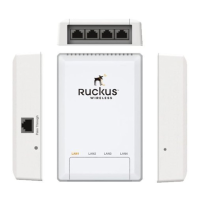
Do you have a question about the Ruckus Wireless ZoneFlex 7025 and is the answer not in the manual?
| Switch type | Unmanaged |
|---|---|
| Switch layer | L2 |
| Console port | RJ-45 |
| Basic switching RJ-45 Ethernet ports type | Fast Ethernet (10/100) |
| Basic switching RJ-45 Ethernet ports quantity | 4 |
| 10G support | No |
| Auto MDI/MDI-X | Yes |
| Networking standards | IEEE 802.11b, IEEE 802.11e, IEEE 802.11g, IEEE 802.11n, IEEE 802.1Q, IEEE 802.1x |
| Throughput | 85 Mpps |
| MAC address table | 100 entries |
| Security algorithms | WEP, WPA-PSK, WPA-TKIP, WPA2-AES |
| Supported network protocols | HTTP/S, CLI (Telnet/SSH) |
| Stackable | - |
| Form factor | 1U |
| Product color | Black |
| DC input voltage | 48 V |
| Power consumption (typical) | 23 W |
| Operating temperature (T-T) | 0 - 50 °C |
| Operating relative humidity (H-H) | 15 - 95 % |
| Depth | 56 mm |
|---|---|
| Width | 85 mm |
| Height | 128 mm |
| Weight | 150 g |
Provides a general overview of the Ruckus Wireless ZoneFlex 7025 Multimedia Wi-Fi Wall Switch, its features, and benefits.
Instructions for safely opening the product package and verifying all included contents.
Lists all physical items included in the ZoneFlex 7025 product package for verification.
Details the physical features of the ZoneFlex 7025 models, including front and rear views.
Explains the meaning and behavior of the status indicator LEDs on the device for monitoring.
Describes the function and usage of the device's reset buttons for rebooting or factory resets.
Step-by-step guide for initial installation and setup of the ZF7025 device, including network preparation.
Covers the physical mounting and cable connection procedures for the device into a wall outlet box.
Procedure for accessing the device's management interface using a web browser and login credentials.
Overview of the web interface layout, including menus, tabs, and workspace for user interaction.
Sets the device name, location, and service provider login information for management.
Defines how the switch connects to the local network and the Internet, including IP addressing.
Configures common wireless parameters and individual WLAN settings for network operation.
Specifies which stations are allowed to join the WLAN, using MAC address restrictions or other controls.
Configures the behavior of the physical LAN ports, including enabling/disabling and VLAN assignment.
Displays the current common wireless settings configured on the device.
Modifies the default username and password for accessing the device's web interface for security.
Sets up access methods like HTTP, HTTPS, Telnet, SSH, and remote management for the device.
Configures the device to send log messages to a specified syslog server for monitoring and analysis.
Provides options to send diagnostic log files to support for troubleshooting purposes.
Allows users to download the current device log file to their local computer for review or backup.
Details methods for updating the device firmware, including manual and automatic upgrade processes.
Explains how to restart the device to apply settings or resolve minor issues without changing configuration.
Restores the device to its original factory settings, erasing all custom configurations.
Utilizes built-in tools like Ping and Traceroute to troubleshoot network connectivity issues.
